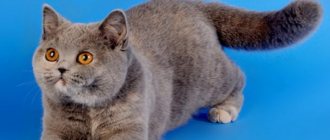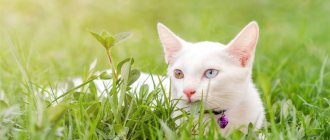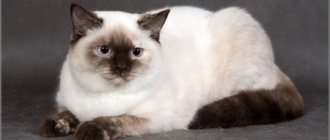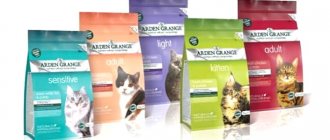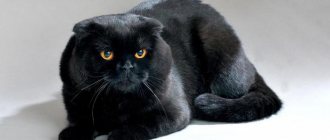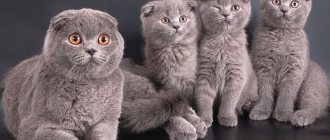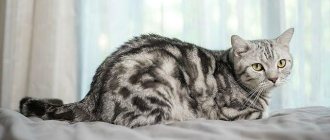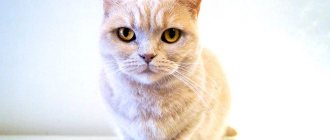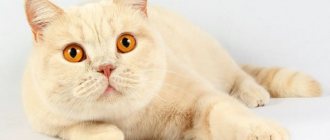The British Fold cat is the result of crossing a purebred British and Scottish cat. The first of them has predominantly cobby-type features, which is expressed in a stocky build with massive legs, rounded shapes and thick hair. While Scottish Folds have a more graceful build and characteristic hanging ears.
The Fold-Eared Briton combines the distinctive characteristics of both representatives, but due to the peculiarities of breeding, it cannot have a pedigree. However, such a kitten will become not just a pet, but also a member of the family with its own character and habits, which will be discussed further.
Do British Fold cats have fold ears?
It is useless to look for a British fold cat on the lists of international felinological clubs: officially such a breed does not exist. Representatives of the British breed are divided only into short-haired and long-haired, but both have straight ears.
The “British” and their relatives the “Scots” came to Russia in the 1990s. To expand the population, breeders began crossing representatives of both varieties.
The result was the appearance of British Fold cats. From their British parents they received short, dense hair on a stocky body, and from their Scottish parents they received curved ears.
The breed began to enjoy popularity, but in 2004 the international felinological community banned the crossing of “British” and “Scots”. The reason is the frequent manifestation of genetic abnormalities in the offspring: pathologies of the joints and too hard coat.
So the lop-eared “British” remained an unrecognized breed and do not have breed standards. Some breeders generally classify them as “rejected” Scottish cats. Therefore, on the lists of international cat breeding clubs you can only find straight-eared “British” cats.
Difference between the British and the Scots
Some ignorant people call Scottish fold cats “British”, but this is wrong. “Scots” are a separate breed, representatives of which are both straight-eared and fold-eared.
It is not difficult to distinguish between “British” and “Scots”. The characteristic appearance features of both breeds are shown in the table.
| British | Scotsman | |
| torso | stocky, well-muscled, rather large | slender, harmoniously built, medium size |
| limbs | strong, large, round paws | graceful, proportional to the body |
| tail | short, thick, with a rounded tip | quite long, wider at the base than at the end |
| head | large, round, high cheekbones, thick cheeks, short neck | small, with a pronounced chin, prominent neck |
| ears | only straight, ends slightly rounded | can be straight (Scottish Straight) or saggy (Scottish Fold) |
| wool | medium length, voluminous, with thick undercoat | soft, less dense than its British relatives |
How did the Scots appear?
The history of the Fold began in Scotland in the 1960s. from one cat that had floppy ears. Due to an unknown mutation, the animal's ear cartilage was unable to hold its ears upright.
Scottish fold
Breeders became interested in such ears and decided to consolidate these qualities. Already by the 1970s. Fold-eared cats, which were given the name “Scottish fold” (“fold” translated as “fold”), were talked about everywhere.
During selection, in order to get more fold-eared kittens, consanguinity could not be avoided. This in turn led to unpleasant consequences - too many sick animals were born. It turned out that the lop ear gene made not only the ears softer, but all the cartilage in the body. Therefore, the health problems of fold-eared cats, primarily with the musculoskeletal system, were very acute. Animals were born with abnormalities, deformities, and died at an early age. Even those kittens that were healthy at birth subsequently developed various defects, sometimes hidden, and inherited.
For this reason, the fold-eared cat was banned in England and Scotland. The International Cat Federation also opposed it, calling the breed “inhumane.”
Description of the breed
The English ancestor gave the “British” a proportionate, strong body with developed muscles, and the Scottish ancestor gave him an amazing variety of colors.
Although there are no breed standards, breeders identify a British Fold cat by the following external characteristics:
- the head is round, cheeky and high cheekbones, the chin is pronounced;
- the nose is short, smooth, slightly flattened;
- the neck is thick, inconspicuous;
- the eyes are large, round, the color of the iris is determined by the color;
- ears are medium in size, straight or curved, the base is wide, the tip is slightly rounded;
- the chest is voluminous and wide;
- the limbs are strong and short, the paws are rounded, the toes are neatly positioned;
- the tail is short, mobile, the tip is slightly narrowed, rounded;
- The coat is dense and pleasant to the touch, the undercoat is voluminous, the hairs are longer and shorter.
ATTENTION! British kittens are not born with droopy ears. Folding ears begin to appear on the 20th day from birth.
Chocolate color standards for the British
There are very strict requirements for the chocolate color of British cats. According to the breed standard, the coat should be short and soft, but the structure should be elastic and not adhere to the animal’s body. A coat that is too soft and tight-fitting to the body or, conversely, a coat that is too harsh are considered serious faults. Due to the thick undercoat, the cat’s skin becomes plush, but excessive fluffiness is unacceptable.
The coat color should be a uniform deep and rich dark brown. Each hair is painted in one tone without play or flow along its entire length. The skin and undercoat are the same shade. The nose is only chocolate, but perhaps a little lighter than the main brown tone. The pads on the paws are also in dark chocolate tones. No stains, stripes, scorches or other effects are allowed by the standard. The animal must have an exceptionally even brown color, which is sometimes called chestnut, associating this color with the color of the ripe horse chestnut fruit. The saturation and density of the shade can vary from the color of a children's milk chocolate bar to a dark chocolate bar with a high cocoa content.
The coat of a Chocolate Briton should be colored evenly, without stripes, spots, marks, etc.
The color of expensive Havana cigars, which are also a rich dark brown, gave these Britons the nickname Havana.
The irises of the chocolate British are allowed only in yellow variations: from light copper to deep dark orange. Without the greenish rim often found in cats.
Chocolate Britons only have yellow eyes
Table: EMS encodings according to international standards WCF and FIFe
| Sign | Code | Name | |
| Breed | BRI | British shorthair | British Shorthair |
| Coat color | b | chocolate (brown, chestnut) | smooth brown or chestnut (chocolate) |
| Tail length | 54 | longy) | normal/long tail |
| Iris color | 62 | yellow, golden | yellow, golden, orange |
| Ears set | 71 | straight ears | straight - straight ears |
The darker and richer the chestnut color of the fur, as well as the brighter the eyes, the more valuable the cat is.
Colors
The coat of a British cat can be either monochromatic or multi-colored, including 2 or 3 colors.
Plain “British” ones are:
- blue (classic version);
- silver-gray;
- white;
- black;
- brown;
- red;
- peach.
Multi-colored cats are:
- tabby (striped color);
- bicolor (a combination of dark and light colors);
- smoky (each hair is transversely divided into two shades);
- "Siamese";
- "tortoiseshells".
Appearance
The British Fold cat breed has similarities with other breeds. And they are often confused. In order not to be confused about what kind of cat you want to see with curled ears, we suggest you find out the appearance of the breed and the differences with others. This breed has many colors, currently there are 182 of them . The classic color remains - blue, or to be more precise - light blue. Among the rest of the British who were crossed with exotic representatives of this species of animals, we can highlight:
- black;
- lilac;
- chocolate;
- cream;
- white;
- bicolor;
- tabby (a characteristic feature of the “M” breed);
- tortoiseshell color;
- chinchilla color;
- Red.
© shutterstock
Character and habits
British fold-eared pets are calm, non-conflicting, non-aggressive, and phlegmatic. They release their claws only when there is obvious danger, but in most cases they prefer to leave and hide. The “British” remains loyal to his owner only if he takes good care of him.
Positive character traits of the British favorite:
- calm;
- unobtrusiveness;
- curiosity;
- tenderness.
The “British” loves affection, but, like a true aristocrat, does not tolerate being squeezed. He tolerates loneliness without problems and does not require the constant presence of his owner. Also, the British cat is extremely picky about the quality and cleanliness of the tray and resting place.
INTERESTING! British cats are afraid of heights, which is not typical for representatives of other breeds.
Negative characteristics:
- inactivity, lethargy;
- voracity;
- detachment, poor communication.
Own territory
British Folds can be called lovers of personal space. Yes, they need privacy, to be with themselves. Unlike other cats, this breed cannot be scared away by rustling bags; they are quite brave. Such attempts to scare away will, at most, result in a surprised face.
Once again, it is worth noting that pets get along well with other animals and are not jealous.
If they tell you that an animal chooses its owner, you can smile - this is not about the British. Pets tend to look at what is happening from above; they can climb to a height and watch what is happening like an emperor.
Relationships with other household members and animals
The British Fold will become a loyal friend and companion for the rest of his cat's life. The cat loves his owner immensely and waits for him to return from work. At the same time, it is unobtrusive and does not require constant attention from a person.
Thanks to his high intelligence, the “British” has a good sense of his master’s mood and knows how to adapt to it. He is not afraid of large crowds of people, noise and din, and shows moderate interest in guests. He is friendly towards other family members and sometimes caresses him.
YOU SHOULD KNOW! The "British" cannot stand human crying. If the owner is whiny and often mopes, then the cat will develop a nervous and aggressive character.
A British Fold cat is an ideal option for a large, calm family. The pet gets along well with children and other pets, even non-aggressive dogs. But he can release his claws if a child mocks him.
Owner reviews
Reviews from owners of British cats are very different. This is easy to explain: each animal has its own character, and each family has a special life situation. These things greatly influence the behavior and habits of the animal.
Flaws.
- The character of the British is “the same”: the pussy will not allow squeezing, kneading, pressing and stroking, picking up without her consent. Carrying a British woman in your arms is an insult to her personality.
- It can raise its paw at its owner, but without claws.
- If the cat is unhappy with life , expect trouble. You may find a “protest” in your bed, and it will be impossible to do anything about it.
- Pickiness to food and toilet are the main shortcomings of the animal. These are “masters” of sorting through food, burying it and turning away from it until their favorite dish is served.
- These cats are curious, they must be anywhere and everywhere, they love to “become mischievous” - throwing various objects down from tables, shelves, sideboards and driving them anywhere.
Advantages.
- The British always want to be with their family. Being close to the owner is the main thing for them. They accompany him everywhere, like a faithful dog, and if he leaves, they wait at the doorstep.
- Cheerful and active when desired, they enjoy playing and communicating.
- They do not meow persistently and impudently. They don’t get their way by organizing concerts, they just tactfully remind people of themselves.
- They carefully take care of themselves, licking their plush fur coat.
- They never get in the way or get underfoot if the owners are busy.
- They do not offend children, even if they do not have warm feelings for them, but most often they become good friends with them. Affectionate and kind, if their owners do not impose on them.
If you decide to get a British cat, be patient and sincerely love the animal, then your feelings will be mutual.
Watch the video to see what it’s like to live with a British cat in the same house.
Features of care
The breed is capricious; the British Fold requires careful care and high-quality nutrition. Therefore, the potential owner should consider whether he is ready to devote a lot of time and effort to the kitten.
Diet
Representatives of the fold-eared breed are gluttonous, so the owner needs to carefully monitor the diet and control the size of portions so that the pet does not become obese. The cat is fed 3-4 times a day, but the size of one portion should not exceed 200 g.
You can feed the “British” with the best quality ready-made food or natural food.
If the second option is chosen, then the diet includes:
- lean boiled meat and poultry;
- boiled fish without bones;
- boiled chicken or quail eggs;
- boiled vegetables (zucchini, carrots);
- fresh herbs (cucumber, parsley);
- cereal porridges (rice, millet, oatmeal);
- fermented milk products (kefir, cottage cheese).
You should not include salted foods, smoked foods, confectionery and bread products, milk and fatty sour cream, alcoholic beverages, spicy and seasoned foods in your diet.
Hygiene procedures
Clean the cat's ears every 2 weeks. Due to lop ears, dirt and wax quickly accumulate in your pet's ears. For cleaning, use a cotton swab soaked in veterinary ear cleaner.
Every morning the British man's eyes are checked. Accumulations in the tear ducts are removed with a cotton swab moistened with warm water.
Nails are trimmed with a nail clipper once every 3 weeks. Leave no more than 3 mm from the edge so as not to touch the blood capillaries.
They bathe the “British” at most once every six months, using zoo shampoo. And then only if necessary, if the animal is dirty or infected with fleas. Frequent bathing spoils the appearance and structure of the coat. The water is heated to 40 °C.
Castration and sterilization
Representatives of the British Fold cat breed reach sexual maturity at 9 months. If the owner does not plan to breed kittens, then the pet must be castrated or sterilized.
The operation can be performed on a 3-month-old kitten, but stronger and more mature 7–8-month-old kittens are more often castrated. Before the procedure, the animal is examined by a veterinarian and given anthelmintic treatment.
IMPORTANT! In most cases, fold-eared kittens are sold already castrated, since felinological societies prohibit the breeding of an unrecognized breed.
Grooming
The British cat's luxurious, dense coat should be brushed regularly. If this is not done, then the animal will, while licking itself, swallow balls of hair that disrupt the functioning of the digestive tract.
The long-haired "British" is scratched 2 times a week, especially carefully walking the comb over the stomach, back of the head and hind legs. A short-haired cat can be brushed once a week.
Dangers
How your pet will feel depends only on you. If it worsens, you should pay attention to your diet. Their food consumption is 30% more than that of a regular cat. If you see health problems, adjust your diet. In addition, lack of attention will also make you anxious. After all, they love attention very much and if it is not enough, then dirty tricks will begin due to insults.
The life of a cat is 12 years, but this is provided that you keep an eye on it and its nutrition. Especially, you need to pay attention to him in the 10th year of life. It would be a good idea to consult a veterinarian and adjust your diet.
Health and vaccination
Fold-eared “Britons” are at risk for genetic pathologies. This is due to the fact that they are descendants of two closely related breeds, one of which carries the gene for lop ears. This gene not only makes the ears original, but can also cause serious pathologies of the skeleton and bone tissue.
IMPORTANT! In kittens born from two lop-eared individuals, osteochondrodysplasia is inevitable - an incurable deformation of the joints. Therefore, fold-eared pets are crossed only with straight-eared ones.
Fold-eared “British” dogs are also susceptible to:
- hearing loss;
- respiratory viral infections;
- claw fungus;
- helminthiasis;
- flea infestation;
- disruption of the heart;
- the appearance of renal cysts.
For preventive maintenance, your pet needs to be shown to a veterinarian annually and vaccinated. Each vaccine is administered according to the time limits established by the veterinarian. Vaccination helps protect your pet from panleukopenia, rabies, and respiratory infections.
A healthy and well-groomed British Fold cat lives about 15 years.
Acquisition
Before you decide to buy British cats with curled ears, you should evaluate your capabilities, both financially and in terms of caring for your pet. Yes, the price of one kitten of this breed may vary. This depends on many factors:
- Purebred.
- Color.
- Age.
- Availability of vaccinations.
It is clear that blue cats will cost significantly more. When purchasing, you don’t have to worry about the young age of your pet. Especially for toilet training.
Price
There are many nurseries selling British fold kittens in Russia; finding a pet is not a problem. The breeder must provide the buyer with a veterinary passport and information about the kitten’s parents.
If prices for a purebred “Scottish” cat reach 50 thousand rubles, then a British kitten is much cheaper, because this fold-eared cat is an unrecognized breed. For a British fold kitten they ask from 1000 to 5000 rubles.
The lop-eared “British” is loyal, affectionate, playful, and behaves with dignity. Although he cannot participate in exhibitions and competitions, since his breed does not officially exist, he will become a wonderful companion for a lonely elderly person and a friend for a large family.
Did you like the article?
Differences
Since the English Fold cat is very similar to the Scottish Fold, animal lovers often confuse them. To avoid confusion, it is worth finding out what their difference is. And the difference is in everything, after reading this you will understand how different these animals are. The differences between them are all over:
- Appearance.
- Character.
- Communication with others.
- Fears.
At first glance, you can see the difference in the photo of the Briton, because... British pets are earthy and stocky. The neck has more defined features, and the tail is much longer. Oddly enough, the ears of these animals are also different.
